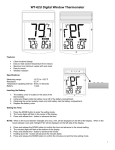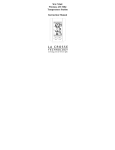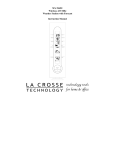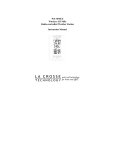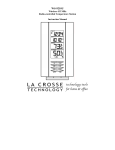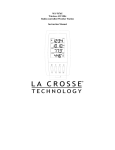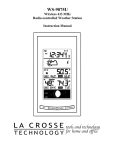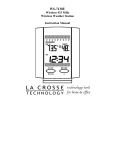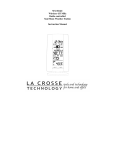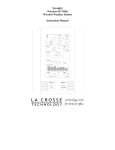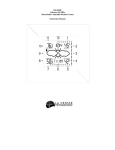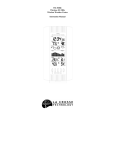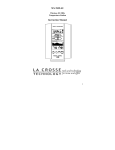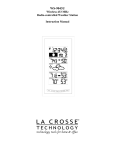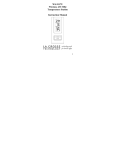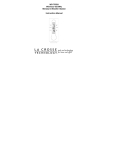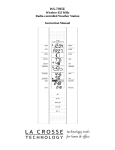Download La Crosse Technology WS-7168U User's Manual
Transcript
WS-7168U Wireless 433 MHz Radio-controlled Weather Station Instruction Manual TABLE OF CONTENTS Topic Inventory of Contents/Additional Equipment About WWVB Quick Set-Up Guide Detailed Set-Up Guide Battery installation Program Mode Program Sequence and Default Settings Function Keys Setting the LCD Contrast Setting the Time Zone Daylight Saving Time Setting Radio-controlled Time Setting 12/24-hour Time Setting Setting the Time Setting the Year, Day and Month Setting the Snooze Setting the Temperature Format Setting the Forecast Sensitivity Features Weather Forecast Icons and Tendency Arrows Indoor Temperature, Humidity, & Comfort Level Indicator Outdoor Temperatures Minimum & Maximum Records (Indoor, Outdoor, & Resetting) Additional Remote Control Sending Units (Set-Up, Viewing, & Operation) Mounting Troubleshooting Maintenance & Care Specifications Warranty Information 2 Page 3 3 4 5 6 6 7 7-8 8 9 9 10-11 11 12 12 13 14-15 15-16 16 16-17 18-19 19-21 22-23 23 24 25-26 INVENTORY OF CONTENTS 1. 2. 3. 4. The WS-7168U weather station (Figure 1). One TX6U remote temperature sensor (Figure 2). Mounting hardware Instruction manual and warranty card. Figure 2 Figure 1 Time and Date LCD Forecast LCD Indoor LCD Outdoor LCD Mounting Bracket TX6U temperature sensor ADDITIONAL EQUIPMENT (not included) 1. 2. 3. Two fresh AA 1.5V batteries for the weather station. Two fresh AA 1.5V batteries for the remote temperature sensor. One Philips screwdriver for mounting. ABOUT WWVB (Radio Controlled Time) The NIST (National Institute of Standards and Technology—Time and Frequency Division) WWVB radio station is located in Ft. Collins, Colorado, and transmits the exact time and date signal continuously throughout the United States at 60 kHz. The signal can be received up to 2,000 miles away through the internal antenna in the Weather Station. However, due to the nature of the Earth’s Ionosphere, reception is very limited during daylight hours. The weather station will search for a signal every night when reception is best. The WWVB radio station derives its signal from the NIST Atomic clock in Boulder, Colorado. A team of atomic physicists is continually measuring every second, of every day, to an accuracy of ten billionths of a second per day. These physicists have created an international standard, measuring a second as 9,192,631,770 vibrations of a Cesium-133 atom in a vacuum. For more information on the atomic clock and WWVB please see the NIST website at http://www.boulder.nist.gov/timefreq/stations/wwvb.htm. 3 QUICK SET-UP GUIDE Hint: Use good quality Alkaline Batteries and avoid rechargeable batteries. 1. 2. 3. 4. Have the indoor weather station and remote temperature sensor 3 to 5 feet apart. Batteries should be out of both units for 10 minutes. Place the batteries into the remote temperature sensor first then into the indoor weather station. (All outdoor remotes must be started before the indoor station) DO NOT PRESS ANY BUTTONS FOR 15 MINUTES. In this time the indoor weather station and remote temperature sensor will start to talk to each other and the display will show the indoor temperature, humidity and an outdoor temperature. If the indoor weather station does not display all information after the 15 minutes please retry the set up as stated above. After all information has been displayed for 15 minutes you can place your sensor outdoors and set your time. The remote temperature sensor should be placed in a dry, shaded area. The remote temperature sensor has a range of 80 feet. Any walls that the signal will have to pass through will reduce distance. An outdoor wall or window can have up to 30 feet of resistance and an interior wall can have up to 20 feet of resistance. Your distance plus resistance should not exceed 80 ft. in a straight line. Note: Fog and mist will not harm your remote temperature sensor but direct rain must be avoided. Note: The remote temperature sensor transmits a signal every minute. After the batteries have been installed, the indoor weather station will search for the signal for a duration of 15 minutes. If there is no temperature reading in the OUTDOOR LCD after 15 minutes, make sure the units are within range of each other, or repeat the battery installation procedure. If a button is pressed before the indoor weather station receives the temperature signal, you will need to follow the battery installation procedure again. To complete the set up of your wireless weather station after the 15 minutes have passed please follow the steps that follow in the Detailed Set-Up Guide. 4 DETAILED SET-UP GUIDE BATTERY INSTALLATION A. REMOTE TEMPERATURE SENSOR 1. 2. 3. 4. Remove the mounting bracket. The bracket snaps on and off easily. Battery Remove the battery cover, by sliding the Cover cover down. Observing the correct polarity install 2 AA batteries. The batteries will fit tightly (to avoid start-up problems make sure they do not spring free). Replace the battery cover by sliding upwards. Be sure battery cover is on securely. B. INDOOR WEATHER STATION 1. 2. 3. Remove the battery cover. To do this, insert a solid object in the space provided at the lowercentral position of the battery cover, then push up and pull out on the battery cover. Observe the correct polarity, and install 2 AA batteries. Replace the battery cover. Battery Cover Note: Immediately after the batteries have been installed, the LCD (Liquid Crystal Display) will flash. Within 15 seconds the indoor temperature, indoor relative humidity, and the weather icons (sun and clouds) will be displayed. If not, remove batteries for 10 seconds and reinstall. If the outdoor temperature is not displayed within four minutes, remove batteries from both units, wait 30 seconds, and reinstall making sure to install batteries into the remote temperature sensor first. The time will show -:-- and start searching for the WWVB signal. If it successfully receives the time signal (usually at night), it will display the correct time (default time-zone is Eastern). You will need to adjust the time zone to match your local time. 5 PROGRAM MODE Programming Note: If 30 seconds is allowed to pass, or the CH button is pressed during the programming mode, the unit will confirm/set the last information entered—the display will stop flashing and return to normal time-date readings. If you don’t leave the program mode during the programming of sections IV through XI, you can advance to step 4 of the next program setting. If you do leave the program setting (or want to program a specific setting) follow each instructional step to program that setting. I. PROGRAMMING SEQUENCE AND DEFAULT SETTINGS The programming sequence and default (factory) settings are as follows: LCD Contrast Time Zone Daylight Saving Time Radio-controlled time reception 12/24-hour time Time Year Day and Month Snooze (this function not used) Temperature Format Forecast Sensitivity 5 -5 (Eastern) 1 (on) ON 12 12:00 2003 1.1. 10 °F 2 Please note that while there is a snooze adjustment in the programming this is an unused function as there is no alarm on the indoor weather station. II. FUNCTION KEYS The function keys are located on the front of the unit directly below the LCD. 6 III. SETTING THE LCD CONTRAST 1. 2. Press and hold the SET button for 5 seconds. “LCD” will show in the time LCD and the number setting will flash. Note: There are 8 LCD contrast levels to choose from—“Lcd 0” is the lightest, and “Lcd 7” is the darkest. 3. 4. Press and release the IN button to select the level you desire. Press and release the SET button to confirm and advance to the Time Zone setting. IV. TIME ZONE SETTING 1. 2. 3. 4. Press and hold the SET button for 5 seconds. “LCD” will show in the time LCD and the number setting will flash. Press and release the SET button again. The time zone will flash (located to the right of the time). 5. Press and release the IN button to select your time zone. Note: When a time zone for the U.S. is selected the corresponding abbreviation will appear above the time (please see the table on the next page). It is possible to select any time zone from –12 GMT to +12 GMT (for example to see the time in another country) 7 TIME ZONES GMT Atlantic EST; Eastern CST; Central MST; Mountain PST; Pacific ALA; Alaska HAW; Hawaii 6. V. 0 -4 -5 -6 -7 -8 -9 -10 Press and release the SET button to confirm and advance to the Daylight Saving Time setting. DAYLIGHT SAVING TIME (DST) SETTING 1. 2. 3. 4. 5. Press and hold the SET button for 5 seconds. “LCD” will show in the time LCD and the number setting will flash. Press and release the SET button twice. “DST” will appear to the right of the time and either “1” or “0” will flash. Press and release the IN button to select DST on or off. “DST 0” indicates that the feature is off and the WWVB will not change times automatically. “DST 1” indicates that the feature is on and the WWVB will change times automatically. Note: Some locations (Arizona and parts of Indiana) do not follow Daylight Saving Time, and should select “DST 0.” 6. Press and release the SET button to confirm and advance to the radio-controlled time on/off setting. 8 VI. RADIO-CONTROLLED TIME ON/OFF SETTING 1. 2. 3. 4. 5. 6. Press and hold the SET button for 5 seconds. “LCD” will show in the time LCD and the number setting will flash. Press and release the SET button three times. “RCC” will appear on the right of the time LCD and “ON” or “OFF” will flash to the left. Press and release the IN button to select radio-controlled time on or off. Press and release the SET button to confirm and advance to the 12/24-hour time setting. VII. 12 OR 24 HOUR TIME SETTING 1. 2. 3. 4. 5. Press and hold the SET button for 5 seconds. “LCD” will show in the time LCD and the number setting will flash. Press and release the SET button four times. “12h” or “24h” will flash in the time LCD. Press and release the IN button to select 12 or 24-hour time format. Note: When in the 12-hour format “P.M.” will appear to the left of the hour in the time LCD between the hours of noon and midnight. 9 6. VIII. Press and release the SET button to confirm and advance to the time setting. TIME SETTING There are two methods by which the time and date can be set: A) Automatically via WWVB reception, or B) Manually. A. WWVB (Remote Control Time) This method requires you to do nothing, except wait for the signal to be received, and to select a time zone. Reception usually takes approximately 10 minutes during optimal conditions. The best condition for reception is at night, between midnight and 6:00 am— when there is less atmospheric interference. To keep your time as accurate as possible, the indoor weather station conducts a WWVB search every night between these hours, and overrides any manually set time. The WWVB tower icon (appearing in the TIME LCD) will flash when a signal-search is in progress and a signal is being received, and will remain steady when the signal has been received. If the WWVB time has not been received after 10 minutes of battery installation, you may manually set the time or leave the time function alone (reception will occur regardless). B. MANUAL TIME SETTING Note: When in the 12-hour format “P.M.” will appear to the left of the hour in the time LCD between the hours of noon and midnight. 1. 2. 3. 4. Press and hold the SET button for 5 seconds. “LCD” will show in the time LCD and the number setting will flash. Press and release the SET button five times. The time will flash in the time LCD. 10 5. 6. 7. Press and release the IN button to advance the hours. Press and release the OUT button to advance the minutes. Press and release the SET button to confirm and advance to the year setting. IX. SETTING THE YEAR, DAY AND MONTH Note: Reception of the WWVB signal will also set the date and day. The reception of the signal will override any programmed date and day. 1. 2. 3. 4. 5. 6. 7. Press and hold the SET button for 5 seconds. “LCD” will show in the time LCD and the number setting will flash. Press and release the SET button six times. The year will flash in the right section of the time LCD. Press and release the IN button to advance the year. Press and release the SET button to confirm and advance to the day/month setting. The day and month will flash in the right section of the time LCD. 8. Press and release the IN button to advance the day. 9. Press and release the OUT button to advance the month. 10. Press and release the SET button to confirm and advance to the snooze setting. 11 X. SETTING THE SNOOZE Note: This is an unused function of the indoor weather station and should be disregarded. The setting has no bearing on the operation. Please press and release the SET button to advance to select the temperature format. XI. SELECTING °F OR °C 1. 2. 3. 4. 5. 6. Press and hold the SET button for 5 seconds. “LCD” will show in the time LCD and the number setting will flash. Press and release the SET button nine times. Either ”°F” or “°C” will flash in the time LCD. Press and release the IN button to select the temperature format. Press and release the SET button to confirm and advance to the forecast sensitivity setting. 12 XII. SETTING THE FORECAST SENSITIVITY Note: The forecast sensitivity can be adjusted to allow for areas that have a higher or lower sensitivity to changing air pressure (for example coastal areas have more pressure change than areas such as southern Arizona). The numbers correspond to the amount of air pressure change necessary to trigger a change in the forecast icon. Areas that tend to have more air pressure change would set the sensitivity to 3, while areas that experience lower than normal air pressure change would set the sensitivity to 1. 1. 2. 3. 4. 5. 6. Press and hold the SET button for 5 seconds. “LCD” will show in the time LCD and the number setting will flash. Press and release the SET button ten times. Either “1”, “2” or “3” will flash in the time LCD. Press and release the IN button to select the forecast sensitivity Press and release the SET button to confirm the forecast sensitivity and complete the programming. 13 FEATURES OF THE WS-7168U Time Zone Indicator WWVB Tower Icon (indicates time reception) Weather Tendency Arrow Forecast icon Comfort Level Indicator Satellite icon (indicates outdoor transmission) I. WEATHER FORECAST The weather forecasting feature is estimated to be 75% accurate and is for the next 12 to 24 hours. The weather forecast is based solely upon the change of air pressure over time. The WS-7168U averages past air-pressure readings to provide an accurate forecast—creating a necessity to disregard all weather forecasting for 12-24 hours after the unit has been set-up, reset, or moved from one altitude to another (i.e. from one floor of a building to another floor). In areas where the weather is not largely affected by the change of air pressure, the sensitivity setting should be set to 1. A. WEATHER ICONS There are 3 possible weather icons that will be displayed in the FORECAST LCD: 14 Sunny—indicates that the weather is expected to improve (not that the weather will be sunny). Sun with Clouds—indicates that the weather is expected to be fair (not that the weather will be sunny with clouds). Clouds with Rain—indicates that the weather is expected to get worse (not that the weather will be rainy). These icons indicate the expected weather change in the next 12 to 24 hours. The icon does not give an exact prediction of the weather, however it should be viewed as a generalization of the expected weather change (for example a “sunny” icon indicates the weather is expected to improve). The weather icons change when the unit detects a change in air pressure. The icons change in order, from “sunny” to “partly sunny” to “cloudy” or the reverse. It will not change from “sunny” directly to “rainy”, although it is possible for the change to occur quickly. If the symbols do not change then the weather has not changed, or the change has been slow and gradual. B. WEATHER TENDENCY ARROWS Other possible displays in the FORECAST LCD are 2 weather tendency arrows, one that points up (on the left side of the LCD) and one that points down (on the right side of the LCD). These arrows reflect current changes in the air pressure. An arrow pointing up indicates that the air pressure is increasing and the weather is expected to improve or remain good, an arrow pointing down indicates that the air pressure is decreasing and the weather is expected to become worse or remain poor. No arrow means the pressure is stable. II. INDOOR TEMPERATURE, HUMIDITY, AND COMFORT LEVEL INDICATOR The current indoor temperature (viewed on the left) and relative humidity (viewed on the right) are displayed in the INDOOR LCD. The comfort level indicator is located at the center of the INDOOR LCD. The indicator 15 will display a happy face icon when the temperature is between 68°F and 79°F (20°C and 25.9°C), and the humidity is between 45% and 65%. A sad face icon will be displayed when the temperature and humidity are outside the mentioned ranges. III. OUTDOOR TEMPERATURE The temperature received from the remote temperature sensor is viewed in the OUTDOOR LCD. When there is more than one remote temperature sensor unit in operation, a “boxed” number will appear to the right of the temperature. This indicates which remote temperature sensor unit (1, 2, or 3) is currently displaying its data in the OUTDOOR LCD. (This feature is explained in further detail in section V—Adding Remote Temperature Sensors). IV. MINIMUM AND MAXIMUM TEMPERATURE RECORDS The WS-7168U keeps a record of the MINIMUM and MAXIMUM temperature, and the time and date of their occurrence—for both the indoor and outdoor modes. A. VIEWING THE INDOOR TEMPERATURE RECORDS 1. Press the IN button once. “MIN” appears above the indoor temperature and the LCD will flash, indicating that the minimum temperature (along with the humidity measured at that time) and the time and date of occurrence are displayed. The minimum records will display for 30 seconds before returning to the normal display mode. 2. Press the IN button again (once while “MIN” is still displayed, twice otherwise). “MAX” appears above the indoor temperature and the LCD will flash, indicating that the maximum temperature (along with the humidity measured at that time) and the time and date of occurrence are displayed. 16 3. While “MAX” is still displayed press the IN button again to return to the current data display. Or you can wait 30 seconds, during either the minimum or the maximum readings, and the unit will automatically return to current data readings. B. VIEWING THE OUTDOOR TEMPERATURE RECORDS 1. 2. 3. Press the OUT button once. “MIN” appears above the outdoor temperature and the LCD will flash, indicating that the minimum temperature, and the time and date of occurrence are displayed. The minimum records will display for 30 seconds before returning to the normal display mode. Press the OUT button again (once while “MIN” is still displayed, twice otherwise). “MAX” appears above the outdoor temperature and the LCD will flash, indicating that the maximum temperature and the time and date of occurrence are displayed. While “MAX” is still displayed press the OUT button again to return to the current data display. Or you can wait 30 seconds, during either the minimum or the maximum readings, and the unit will automatically return to current data readings. C. RESETTING THE MIMIMUM AND MAXIMUM RECORDS 1. 2. All the Indoor records (minimum and maximum) will be reset after the IN button is pressed and held for 5 seconds. All the Outdoor records (minimum and maximum) will be reset after the OUT button is pressed and held for 5 seconds. 17 V. ADDING REMOTE TEMPERATURE SENSORS (OPTIONAL) The WS-7168U is able to receive signals from 3 different remote temperature sensors. The remote temperature sensor model(s) that you choose will come with their own set of instructions—follow these instructions for a complete guide to setting up. Following are some brief instructions for the basic set-up of remote temperature sensor units with the WS-7168U. These extra sensors can be purchased through the same dealer as this unit, or by contacting La Crosse Technology directly. A TX6U will monitor temperature only, a TX3U will monitor temperature and display the temperature on its LCD, and the TX3UP will monitor the temperature via a probe for use in pools, spas, etc. Note: When setting up multiple units it is important to remove the batteries from all existing units in operation, then to insert batteries first into all the remote temperature sensor units, and in numeric sequence. Second install batteries into the indoor weather station. Transmission problems will arise if this is not done correctly and if the total time for set-up exceeds 6 minutes. A. SET-UP OF MULTIPLE UNITS 1. 2. 3. 4. 5. 6. It is necessary to remove the batteries from all units currently in operation. Remove the battery covers to all remote temperature sensor units. Place all remote temperature sensor units in a numeric sequential order. In sequential order, install batteries (follow the same battery installation procedures seen in section I. A) of the Detailed Set-Up Guide). Install batteries into the indoor weather station. Follow the Detailed Set-Up Guide for programming and operating instructions. 18 B. VIEWING AND OPERATING WITH MULTIPLE REMOTE TEMPERATURE SENSOR UNITS 1. 2. 3. To view the temperature of a different remote temperature sensor unit, press and release the CH button. A shift from one “boxed” number to the next should be observed in the OUTDOOR LCD. To view the Minimum/Maximum temperature: first select which remote temperature sensor to read data from (indicated by the “boxed” number), then press the OUT button. Pressing this button once will display the minimum temperature, and the date and time the data was recorded. Pressing this button a second time (while “MIN” is still displayed, otherwise press the button twice) will display the same data for the maximum recordings. To reset the Minimum/Maximum readings, it is necessary to select which remote temperature sensor you wish to reset. Press and hold the OUT button for 5 seconds, the records for the selected remote temperature sensor unit will be reset. MOUNTING Note: Before permanently mounting ensure that the indoor weather station is able to receive WWVB signals from the desired location. Also, extreme and sudden changes in temperature will decrease the accuracy of the indoor weather station, and changes in elevation will result with inaccurate weather forecasting for the next 12 to 24 hours. These changes will require a 12 to 24 hour wait before obtaining reliable data. To achieve a true temperature reading, avoid mounting where direct sunlight can reach the remote temperature sensor or indoor weather station. While the remote temperature sensor is weather proof, avoid submersion in water or snow. We recommend that you mount the remote temperature sensor on an outside North-facing wall. The sending range is 80ft—obstacles such as walls, concrete, and large metal objects can reduce the range. Place both units in their desired location, and wait approximately 15 minutes before permanently mounting to ensure that there is proper reception. The indoor weather station should display a temperature in the OUTDOOR LCD within 4 minutes of setting up. 19 I. THE REMOTE TEMPERATURE SENSOR The remote temperature sensor can be mounted in two ways: • with the use of screws, or • using the adhesive tape. A. MOUNTING WITH SCREWS 1) Remove the mounting bracket from the remote temperature sensor. 2) Place the mounting bracket over the desired location. 3) Through the three screw holes of the bracket, mark the mounting surface with a pencil. 4) Screw mounting bracket onto the mounting surface. Ensure that the screws are flush with the bracket. 5) Insert the remote temperature sensor into the bracket. B. MOUNTING WITH ADHESIVE TAPE 1) With a nonabrasive solution, clean and dry the back of the mounting bracket and the mounting surface to ensure a secure hold. The mounting surface should be smooth and flat. 2) Remove the protective strip from one side of the tape. 3) Adhere the tape to the designated area on the back of the mounting bracket. 4) Remove the protective strip from the other side of the tape. 5) Position the remote temperature sensor in the desired location, ensuring that the indoor weather station can receive the signal. II. THE INDOOR WEATHER STATION The indoor weather station can be mounted in two ways: • with the table stand or, • on the wall with the use of a wall hanging screw (not included). 20 A. USING THE TABLE STAND The indoor weather station comes with the table stand already mounted. If you wish to use the table-stand all that is required is to place the indoor weather station in an appropriate location. B. WALL MOUNTING 1) Remove the table-stand. To do this, pull down on the stand from the rear and rotate forward. 2) Fix a screw (not included) into the desired wall, leaving approximately 3/16 of an inch (5mm) extended from the wall. 3) Place the indoor weather station onto the screw using the hanging hole on the backside. 4) Gently pull the indoor weather station down to lock the screw into place. 21 TROUBLESHOOTING NOTE: For problems not solved, please contact La Crosse Technology. Problem: No reception of WWVB time signal. Solution: 1) Wait overnight for signal. 2) Be sure indoor weather station is at least 6 feet from any electrical devices, such as televisions, computers, or other radio-controlled clocks. 3) Remove batteries for five minutes, reinsert and leave the unit alone overnight without pressing buttons. 4) If there are still problems, contact La Crosse Technology. Problem: Hour is incorrect (minute and date are correct). Solution: Be sure correct time zone and daylight saving time settings are selected. Problem: The LCD is faint. Solution: 1) Set the LCD contrast to a higher number. 2) Replace the batteries Problem: No outdoor temperature is displayed. Solution: 1) Remove all batteries, reinsert into remote temperature sensor first, then the indoor weather station. 2) Place the remote temperature sensor closer to the display. 3) Be sure all batteries are fresh. 4) Place the remote temperature sensor and indoor weather station in position so the straight-line signal is not passing through more than two or three walls. Problem: Temperatures do not match if units are placed next to each other. Solution: Each temperature sensor is manufactured to be accurate to within 2 degree plus or minus and under normal conditions, so two sensors could be as much as 4 degrees different. However, the difference can be exaggerated further because the sensors are designed for different working environments. The indoor temperature sensor is less responsive to ambient air currents because of the shielding effect of the display's case. In addition, the case can act as a heat sink to absorb and store heat from external sources (i.e. handling of the case or radiant heat). Also, the much 22 greater range of the remote temperature sensor requires a different calibration curve than the indoor range. Error is usually greater at the extreme ends of a range, making it harder to compare different ranges with different curves. Under non-laboratory conditions, it is difficult to compensate for the above factors and obtain an accurate comparison. MAINTENANCE AND CARE INSTRUCTIONS • • • • • Extreme temperatures, vibration, and shock should be avoided to prevent damage to the units. Clean displays and units with a soft, damp cloth. Do not use solvents or scouring agents; they may mark the displays and casings. Do not submerge in water. Immediately remove all low powered batteries to avoid leakage and damage. Opening the casings invalidates the warranty. Do not try to repair the unit. Contact La Crosse Technology for repairs. SPECIFICATIONS Temperature measuring range: Indoor: 14.2°F to 139.8°F with 0.1°F resolution. (-9.9°C to 59.9°C with 0.1°C resolution). “OFL” displayed if outside this range. Outdoor: -21.8°F to 157.8°F with 0.1°F resolution. (-29.9°C to 69.9°C with 0.1°C resolution). “OFL” displayed if outside this range. Indoor relative humidity measuring range: Indoor temperature checking interval: Indoor Humidity checking interval: Outdoor temperature checking interval (remote temperature 1% to 99% with 1% resolution. (“- -” displayed if outside this range. Every 10 seconds. Every 1 minute. Every 1 minute. 23 sensor): Outdoor temperature reception (indoor weather station): Transmission range: Power Supply: Indoor weather station: Remote temperature sensor: Battery life cycle: Recommended battery type: Dimensions (H x W x D) Indoor weather station (without stand): Remote temperature sensor: Every 5 minutes. 80 feet (in open space). 2 x AA, IEC LR6, 1.5V. 2 x AA, IEC LR3, 1.5V. Approximately 12 months. Alkaline. 3.875“ x 3.875“ x 1.25“ (98 x 98 x 32 mm). 5.04“ x 1.57“ x 0.9“ (128 x 40 x 23 mm) WARRANTY INFORMATION La Crosse Technology, Ltd provides a 1-year limited warranty on this product against manufacturing defects in materials and workmanship. This limited warranty begins on the original date of purchase, is valid only on products purchased and used in North America and only to the original purchaser of this product. To receive warranty service, the purchaser must contact La Crosse Technology, Ltd for problem determination and service procedures. Warranty service can only be performed by a La Crosse Technology, Ltd authorized service center. The original dated bill of sale must be presented upon request as proof of purchase to La Crosse Technology, Ltd or La Crosse Technology, Ltd’s authorized service center. La Crosse Technology, Ltd will repair or replace this product, at our option and at no charge as stipulated herein, with new or reconditioned parts or products if found to be defective during the limited warranty period specified above. All replaced parts and products become the property of La Crosse Technology, Ltd and must be returned to La Crosse Technology, Ltd. Replacement parts and products assume the remaining original warranty, or ninety (90) days, whichever is longer. La Crosse Technology, Ltd will pay all expenses for labor and materials for all repairs covered by this warranty. If necessary repairs are not covered by this warranty, or if a product is examined which is not in need or repair, you will be charged for the repairs or examination. The owner must pay any shipping charges incurred in getting your La Crosse Technology, Ltd product to a La Crosse Technology, Ltd authorized service center. La Crosse 24 Technology, Ltd will pay ground return shipping charges to the owner of the product to a USA address only. Your La Crosse Technology, Ltd warranty covers all defects in material and workmanship with the following specified exceptions: (1) damage caused by accident, unreasonable use or neglect (including the lack of reasonable and necessary maintenance); (2) damage occurring during shipment (claims must be presented to the carrier); (3) damage to, or deterioration of, any accessory or decorative surface; (4) damage resulting from failure to follow instructions contained in your owner’s manual; (5) damage resulting from the performance of repairs or alterations by someone other than an authorized La Crosse Technology, Ltd authorized service center; (6) units used for other than home use (7) applications and uses that this product was not intended or (8) the products inability to receive a signal due to any source of interference.. This warranty covers only actual defects within the product itself, and does not cover the cost of installation or removal from a fixed installation, normal set-up or adjustments, claims based on misrepresentation by the seller or performance variations resulting from installation-related circumstances. LA CROSSE TECHNOLOGY, LTD WILL NOT ASSUME LIABILITY FOR INCIDENTAL, CONSEQUENTIAL, PUNITIVE, OR OTHER SIMILAR DAMAGES ASSOCIATED WITH THE OPERATION OR MALFUNCTION OF THIS PRODUCT. THIS PRODUCT IS NOT TO BE USED FOR MEDICAL PURPOSES OR FOR PUBLIC INFORMATION. THIS PRODUCT IS NOT A TOY. KEEP OUT OF CHILDREN’S REACH. This warranty gives you specific legal rights. You may also have other rights specific to your State. Some States do no allow the exclusion of consequential or incidental damages therefore the above exclusion of limitation may not apply to you. For warranty work, technical support, or information contact: La Crosse Technology 2809 Losey Blvd. S. La Crosse, WI 54601 Phone: 608.782.1610 Fax: 608.796.1020 e-mail: [email protected] (warranty work) [email protected] (information on other products) web: www.lacrossetechnology.com 25 FCC DISCLAIMER THIS DEVICE COMPLIES WITH PART 15 OF THE FCC RULES. OPERATION IS SUBJECT TO THE FOLLOWING TWO CONDITIONS: 1. THIS DEVICE MAY NOT CAUSE HARMFUL INTERFERENCE, AND 2. THIS DEVICE MUST ACCEPT INTERFERENCE RECEIVED, INCLUDING INTERFERENCE THAT MAY CAUSE UNDESIRED OPERATION. FCC ID: OMO-01RX (Receiver), OMO-01TX (sensor) Freq. 433.92 MHz La Crosse Technology Made in China WS-7168U 081703 All rights reserved. This handbook must not be reproduced in any form, even in excerpts, or duplicated or processed using electronic, mechanical or chemical procedures without written permission of the publisher. This handbook may contain mistakes and printing errors. The information in this handbook is regularly checked and corrections made in the next issue. We accept no liability for technical mistakes or printing errors, or their consequences. All trademarks and patents are acknowledged. 26


























